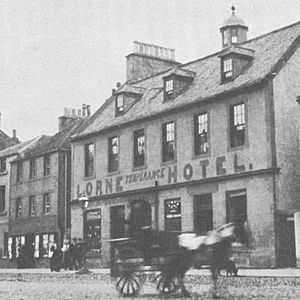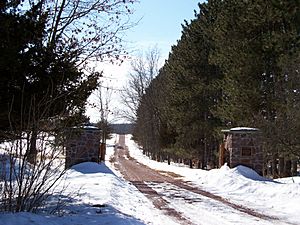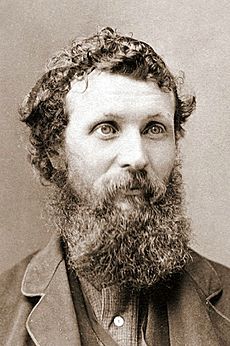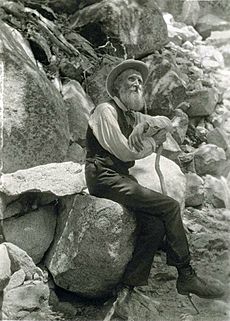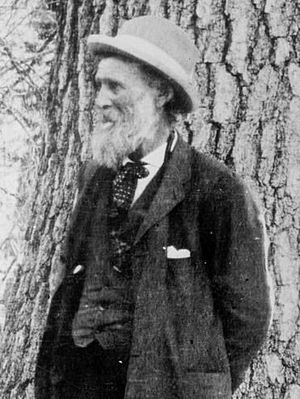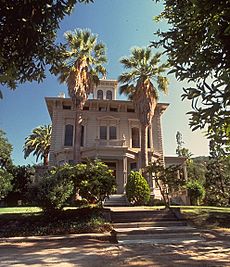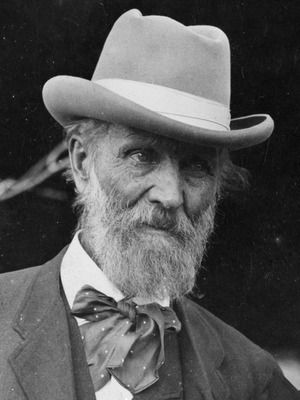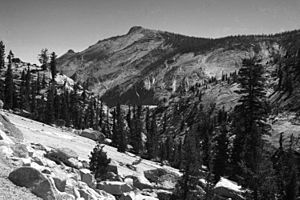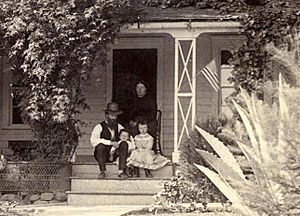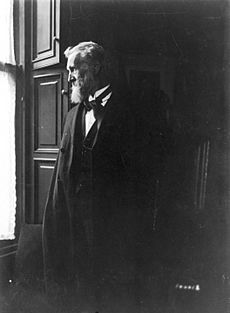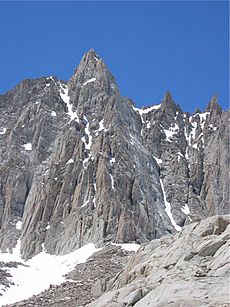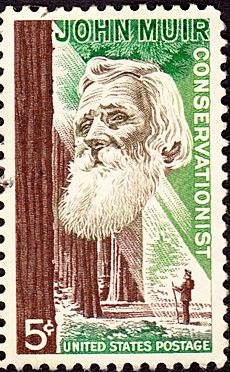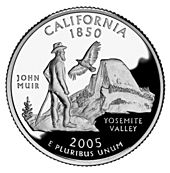John Muir facts for kids
Quick facts for kids
John Muir
|
|
|---|---|
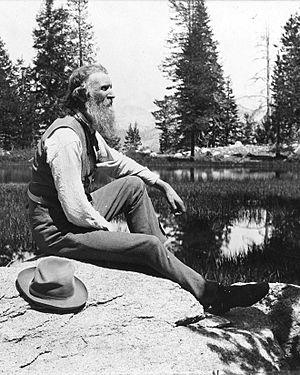
Muir c. 1902
|
|
| Born | April 21, 1838 Dunbar, East Lothian, Scotland
|
| Died | December 24, 1914 (aged 76) Los Angeles, California, U.S.
|
| Alma mater | University of Wisconsin–Madison |
| Occupation |
|
| Spouse(s) |
Louisa Strentzel
(m. 1880–1905) |
| Children | 2 |
| Signature | |
John Muir (mure; April 21, 1838 – December 24, 1914) was a very important Scottish-American naturalist, writer, and environmental philosopher. People often called him "John of the Mountains" or the "Father of the National Parks". He worked hard to protect wild places in the U.S.A..
His exciting stories about nature, especially in the Sierra Nevada mountains, have been read by many. John Muir's efforts helped save famous places like Yosemite Valley and Sequoia National Park. He also helped start the Sierra Club, a big group that works to protect nature. Later in his life, Muir spent most of his time trying to save the forests in the Western U.S. His writings inspired many, including presidents, to protect large natural areas.
John Muir is seen as an inspiration for both Scottish and American people. Many believe he became a "patron saint" of American environmental work. His ideas have greatly shaped how Americans think about their connection to nature.
Contents
Early Life and Adventures
Boyhood in Scotland
John Muir was born in a four-story stone house in Dunbar, Scotland. He was the third of eight children. From a young age, he loved exploring the coastline and countryside near his home. This is where his love for nature began.
His father was very strict about religion. He believed anything that took away from Bible studies was wrong. But young John was a "restless spirit" and often got into trouble. Despite this, he became very interested in nature and the work of other naturalists.
Even though he lived most of his life in America, Muir never forgot Scotland. He loved the Scottish countryside and admired Scottish writers like Robert Burns. He even carried Burns' poems with him on his travels. He visited Scotland again in 1893. He still had his Scottish accent because he was 11 when his family moved to America.
Moving to America
In 1849, John Muir's family moved to the United States. They started a farm near Portage, Wisconsin, called Fountain Lake Farm. His father felt the church in Scotland wasn't strict enough.
By age 11, John had memorized most of the Bible. But as he grew up, he started to see nature as another way to understand God. He felt that nature was "uncorrupted by civilization."
When he was 22, Muir went to the University of Wisconsin–Madison. He paid for his studies himself. There, he took his first botany lesson, which made him very excited about plants. He studied chemistry and other sciences, even though he never officially graduated. He learned a lot about geology and plants, which helped him later in life.
In 1864, Muir left school and traveled to Canada to avoid being drafted into the American Civil War. He spent time exploring forests and swamps, collecting plants. He worked at a sawmill and continued to study nature.
In 1866, Muir returned to the U.S. and worked in a wagon wheel factory in Indianapolis. He was good at inventing things and improving machines. But in 1867, a tool slipped and injured his eye. He was worried he might go blind. When his sight returned after six weeks, he saw the world differently. He decided to follow his dream of exploring nature.
A Thousand-Mile Walk
In September 1867, Muir began a long walk of about 1,000 miles from Kentucky to Florida. He wanted to take the "wildest, leafiest, and least trodden way." He wrote about this journey in his book A Thousand-Mile Walk to the Gulf.
In Florida, he got very sick with malaria. He almost died but was cared for by a kind family. After he recovered, he sailed to Cuba to study plants, then to New York City, and finally booked passage to California.
Exploring California's Wilderness
Discovering Yosemite
When Muir arrived in San Francisco, he immediately went to Yosemite. He was amazed by the landscape, climbing cliffs and exploring waterfalls. He later returned to Yosemite and worked as a shepherd for a while. He climbed mountains and hiked trails, always observing nature.
Muir built a small cabin by Yosemite Creek, with a stream flowing through it. He lived there for two years, writing about his experiences in his book First Summer in the Sierra. His time in Yosemite was like a life-changing experience for him.
Friends and Mentors
During his years in Yosemite, Muir was unmarried and often didn't have a job. He found comfort in nature and in the writings of other naturalists. He often explored alone, carrying only a few supplies and a copy of a book by Ralph Waldo Emerson.
As time passed, Muir became well-known in Yosemite for his knowledge of nature and his storytelling. Many visitors, including scientists and artists, came to meet him.
In 1871, Ralph Waldo Emerson visited Yosemite and met Muir. Emerson was very impressed with Muir. He even offered Muir a teaching job at Harvard, but Muir turned it down. He said he would never give up "God's big show for a mere profship!"
Muir also became close friends with William Keith, a landscape painter from California. They were both born in Scotland and loved the mountains.
Studying Geology and Plants
Muir spent his free time studying geology. He became convinced that glaciers had shaped Yosemite Valley, which was different from what most scientists believed at the time. He found an active glacier in 1871, which helped prove his ideas.
An earthquake in 1872 shook Yosemite Valley. Muir was excited by it, seeing it as a natural event that helped shape the landscape. This event also helped people believe his ideas about how the valley was formed.
Besides geology, Muir also studied plants in Yosemite. He researched the giant Giant Sequoia trees. In 1876, his paper on the subject was published.
Adventures in the Pacific Northwest
Muir made four trips to Alaska. In 1879, he and a group of Native American guides were the first Euro-Americans to explore Glacier Bay. Later, Muir Glacier was named after him.
He explored parts of British Columbia and recorded over 300 glaciers. In 1881, he was part of a group that claimed Wrangel Island for the United States. He wrote about these trips in his journals and newspaper articles.
In 1888, after managing a fruit ranch for seven years, Muir's health suffered. He went back to the mountains to recover, climbing Mount Rainier in Washington.
Working to Protect Nature
Saving Yosemite National Park
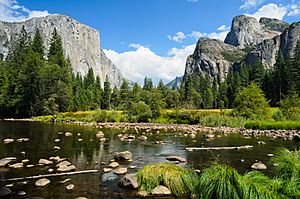
Muir became a strong advocate for protecting nature. He believed that farm animals, especially sheep, were harming the wild lands of Yosemite and the Sierra. He called them "hoofed locusts."
In 1889, Robert Underwood Johnson, an editor from The Century magazine, camped with Muir. He saw the damage caused by sheep. Johnson agreed to publish Muir's articles about keeping livestock out of the Sierra. He also promised to help pass a bill in Congress to make Yosemite a national park, like Yellowstone National Park.
On September 30, 1890, the U.S. Congress passed a bill that followed Muir's ideas. This bill created Yosemite National Park. However, Muir was disappointed that Yosemite Valley itself remained under state control.
Starting the Sierra Club
In 1892, Muir helped start the Sierra Club, a group for people who loved mountains. He was elected its first president and remained president for 22 years until his death.
The Sierra Club immediately worked to protect Yosemite National Park from being made smaller. They also held educational meetings. The club was very important in getting Yosemite National Park transferred from state to federal control in 1906.
Different Ideas About Conservation
In 1896, Muir met Gifford Pinchot, another important leader in the conservation movement. Pinchot was the first head of the United States Forest Service. He believed in using natural resources wisely for people's benefit, like "tree farming" without destroying forests.
Muir, however, valued nature for its beauty and spiritual qualities. He saw national parks as "places for rest, inspiration, and prayers." He encouraged people to experience nature for their souls. Both men were against destroying natural resources, but their ideas about how to manage them were different.
Their friendship ended in 1897 when Pinchot supported sheep grazing in forest reserves. Muir was very upset. This disagreement split the conservation movement into two groups: Muir's "preservationists" who wanted to protect nature as it was, and Pinchot's "conservationists" who focused on managing resources for use.
Their different views became very clear during the debate over whether to dam Hetch Hetchy Valley for water. Pinchot supported the dam, saying it was the "highest possible use." Muir strongly opposed it, saying, "Dam Hetch Hetchy! As well dam for water-tanks the people's cathedrals and churches."
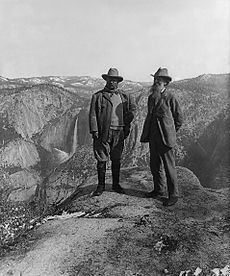
In 1903, President Theodore Roosevelt visited Yosemite with Muir. Muir told the president about the problems with state control of the valley. He convinced Roosevelt that the best way to protect Yosemite was under federal control.
Muir and Roosevelt camped together in the park's backcountry. Roosevelt later said, "Lying out at night under those giant Sequoias was like lying in a temple built by no hand of man." Muir also loved the trip, writing, "Camping with the President was a remarkable experience. I fairly fell in love with him."
After this trip, Muir and the Sierra Club worked harder to get Yosemite Valley under federal control. In 1906, Congress transferred the valley to the national park.
A Nature Writer
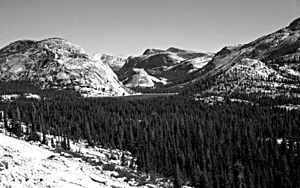
John Muir published six books during his life, all about his explorations in nature. Four more books were published after he died. His writings were very important because they helped Americans want to protect wild places.
Muir's writing style was not easy for him. He worked very hard, often rewriting sentences many times. He liked simple English and admired writers like Henry David Thoreau. His secretary said that writing was "slow and laborious for him." Muir often felt that words couldn't fully capture the beauty of nature. He once wrote, "One day's exposure to mountains is better than a cartload of books."
Jeanne Carr: Friend and Guide
Muir's friendship with Jeanne Carr greatly influenced his career as a naturalist and writer. They met in 1860 when she saw his inventions at a fair and recognized his talent. She and her husband, Professor Ezra Carr, became his friends while he was at the University of Wisconsin.
Jeanne Carr encouraged Muir in his explorations and writings. She sent many of her friends to Yosemite to meet him. She also tried to get his letters published. Muir trusted her as his "spiritual mother," and they remained friends for 30 years. She helped him find his voice and purpose as a writer.
Muir's Beliefs
Nature and God
John Muir grew up in a strict Presbyterian family. His father made him read the Bible every day. But as Muir explored nature, he began to see it as another "primary source for understanding God." He believed that in the wilderness, he could study plants and animals in an environment that "came straight from the hand of God."
Muir felt that his writings should not just describe nature but also show its spiritual meaning. He believed that God was always active in creating life. He saw nature as a great teacher, revealing "the mind of God." This belief became the main idea in his journeys and writings.
Muir often felt a deep connection to the "divine in nature." He was very fond of Henry David Thoreau and saw himself as Thoreau's "disciple."
Nature as Home
Muir often used the word "home" to describe nature. He saw nature as providing a home for even the smallest plants. He also felt that the mountains were his own home, calling the Sierra "God's mountain mansion." He felt a connection to everything in nature, saying, "The very stones seem talkative, sympathetic, brotherly."
Later in his life, he used this idea of nature as home to encourage people to protect wilderness. He once told a visitor at his ranch, "This is a good place to be housed in during stormy weather... but it is not my home. Up there," he said, pointing to the Sierra Nevada, "is my home."
Views on People
Muir's views on Native Americans changed over time. At first, he had mixed feelings, but later he praised their low impact on the wilderness. He felt they lived in peace with nature, unlike European Americans who caused more damage.
Muir also spoke and wrote about the equality of all people, "regardless of color, or race." He wrote about how wrong slavery was in his last book, Travels in Alaska.
Personal Life
In 1878, when he was almost 40, Muir's friends encouraged him to settle down. He met Louisa Strentzel, whose family owned a large fruit orchard in Martinez, California. In 1880, Muir and Louisa married.
John Muir worked with his father-in-law managing the fruit farm for ten years. Even though he was a loving husband and father to his two daughters, Wanda and Helen, his heart still longed for the wild. His wife understood this and would sometimes send him back to the mountains when she saw he was restless. He sometimes took his daughters with him.
The house and part of the ranch are now the John Muir National Historic Site. Muir became a U.S. citizen in 1903.
Death
John Muir died on December 24, 1914, at age 76, from pneumonia. He was in Los Angeles to see his daughter, Helen.
Legacy and Honors
During his life, John Muir published over 300 articles and 12 books. He helped start the Sierra Club, which has grown to have millions of members today.
Muir is known as the "patron saint of the American wilderness." His powerful words changed how Americans saw their mountains, forests, and deserts. He not only led efforts to protect wild areas but also taught people to respect all life.
Muir believed that all life was sacred. He saw nature as a way to connect with God. His friend, Henry Fairfield Osborn, noted that Muir believed "all the works of nature are directly the work of God." Many believe his writings are still a very important force for protecting nature today.
The University of the Pacific keeps many of Muir's books and personal papers. They also have a John Muir Center for Environmental Studies.
Tributes and Honors
California celebrates John Muir Day every year on April 21, his birthday. He was the first person in California to have a special day named after him.
Many places are named after John Muir, including:
- Mount Muir in California and Alaska
- Muir Glacier and Muir Inlet in Alaska
- John Muir Trails in California, Tennessee, Connecticut, and Wisconsin
- John Muir Wilderness in the Sierra Nevada
- Muir Pass in Sequoia and Kings Canyon National Parks
- Muir Woods National Monument near San Francisco
- John Muir National Historic Site in Martinez, California
- Camp Muir in Mount Rainier National Park
- John Muir College at the University of California, San Diego
- John Muir Way, a long trail in Scotland
John Muir has been featured on two U.S. postage stamps. His image also appears on the California state quarter coin, released in 2005. In 2006, he was inducted into the California Hall of Fame.
The John Muir Trust is a Scottish charity that works to protect wild lands. The John Muir Birthplace Charitable Trust supports his birthplace in Dunbar, which is now a museum. A statue of young Muir stands outside the house.
Several plants and animals have been named after John Muir, including a mineral called Muirite. In 2006, he was inducted into the Hall of Great Westerners.
See also
 In Spanish: John Muir para niños
In Spanish: John Muir para niños


